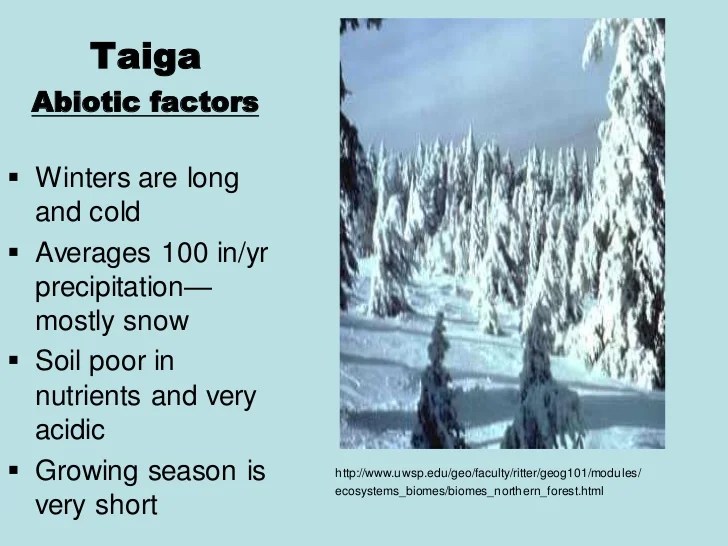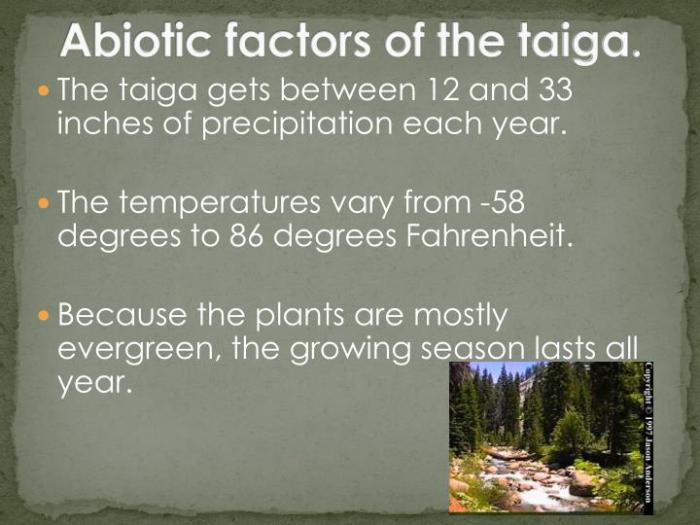The abiotic factors of the taiga biome, encompassing climatic conditions, soil characteristics, hydrological features, geological formations, and fire regimes, exert a profound influence on the structure, function, and dynamics of this vast northern forest ecosystem.
These abiotic factors interact in complex ways, creating a mosaic of habitats that support a diverse array of plant and animal species. Understanding these factors is crucial for comprehending the intricate functioning of the taiga biome and its role in global ecological processes.
Climatic Factors

The taiga biome experiences a wide range of temperatures and seasonal variations. Winters are long and cold, with average temperatures dropping below freezing for several months. Summers, on the other hand, are short and relatively warm, with temperatures reaching into the mid-teens.
These extreme temperature fluctuations have a significant impact on the ecosystem, shaping the distribution of plant and animal life.
Precipitation Patterns
Precipitation in the taiga biome is primarily in the form of snow during the winter months. The total annual precipitation varies from region to region, but it generally ranges from 300 to 600 mm. This precipitation is essential for the growth of plants, but it can also lead to flooding during the spring and summer months.
Sunlight and Day Length
The taiga biome experiences long days during the summer months and short days during the winter months. This variation in day length has a significant impact on the vegetation. During the summer, the long days allow plants to photosynthesize for extended periods, which contributes to their rapid growth.
In contrast, the short days of winter limit the amount of photosynthesis that can occur, which slows down plant growth.
Soil Conditions

The soil in the taiga biome is generally acidic and nutrient-poor. This is due to the cold climate, which slows down the decomposition of organic matter. The soil is also often waterlogged, which further inhibits the growth of plants.
Permafrost
Permafrost is a layer of soil that remains frozen for at least two consecutive years. It is found in the northernmost regions of the taiga biome. Permafrost has a significant impact on soil development and plant growth. It prevents the roots of plants from penetrating the soil, which limits their access to water and nutrients.
Soil Acidity and Nutrient Availability
The acidity of the soil in the taiga biome is influenced by several factors, including the type of bedrock, the amount of precipitation, and the presence of organic matter. Acidic soils are typically low in nutrients, which can limit the growth of plants.
Hydrological Factors
The taiga biome is home to a number of major rivers and lakes. These water bodies provide important habitat for fish and other aquatic organisms. They also play a role in the transportation of nutrients and the regulation of water flow.
Wetlands and Peatlands
Wetlands and peatlands are common features of the taiga biome. These areas are often waterlogged and have a high concentration of organic matter. Wetlands and peatlands provide important habitat for a variety of plants and animals. They also play a role in the storage of carbon and the regulation of water flow.
Snowmelt and Flooding
Snowmelt and flooding are common occurrences in the taiga biome. Snowmelt can lead to flooding in the spring and summer months. Flooding can damage infrastructure and displace wildlife. However, it can also be beneficial to the ecosystem by replenishing water supplies and nutrients.
Geologic Features

The taiga biome is located on a variety of geologic formations. These formations include igneous, sedimentary, and metamorphic rocks. The type of bedrock has a significant impact on the soil conditions and the vegetation of the region.
Topography and Elevation
The topography of the taiga biome is generally flat, with rolling hills and gentle slopes. However, there are some mountainous regions, such as the Ural Mountains in Russia. Elevation has a significant impact on the climate and vegetation of the taiga biome.
Higher elevations are typically colder and have a shorter growing season.
Glacial Landforms
Glacial landforms are common in the taiga biome. These landforms were created by glaciers that covered the region during the last ice age. Glacial landforms include moraines, eskers, and drumlins. These landforms can provide important habitat for plants and animals.
Fire Regimes: Abiotic Factors Of The Taiga Biome
Wildfires are a common occurrence in the taiga biome. These fires are often started by lightning strikes or human activity. Wildfires can burn large areas of forest, but they can also be beneficial to the ecosystem. Fires can clear out dead trees and brush, which makes way for new growth.
They can also release nutrients into the soil, which can benefit plants.
Frequency and Intensity of Wildfires
The frequency and intensity of wildfires in the taiga biome varies from region to region. In some areas, wildfires occur every few years, while in other areas they may occur only once every century. The intensity of wildfires is also influenced by the type of vegetation and the weather conditions.
Role of Fire in Shaping the Taiga, Abiotic factors of the taiga biome
Fire plays a significant role in shaping the composition and structure of taiga forests. Fires can create openings in the forest canopy, which allows sunlight to reach the forest floor. This sunlight can stimulate the growth of new trees and shrubs.
Fires can also kill insects and diseases that can damage trees. In addition, fires can release nutrients into the soil, which can benefit plants.
User Queries
What is the dominant soil type in the taiga biome?
Podzols, characterized by their acidic nature and nutrient-poor composition.
How do wildfires impact the taiga ecosystem?
Wildfires play a crucial role in shaping forest structure, nutrient cycling, and ecosystem recovery, creating a mosaic of habitats for diverse species.